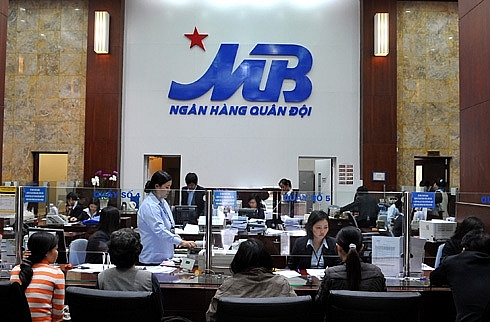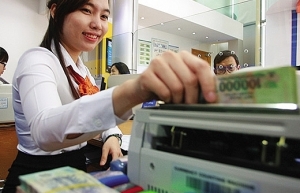Moody’s upgrades rating of four banks in Vietnam
Moody’s has also affirmed the foreign currency deposit ratings of the first three banks at B2, with the ratings were constrained by Vietnam’s foreign currency deposit ceiling of B2.
The credit rating agency has upgraded the Baseline Credit Assessments (BCA) for the three banks to b1 from b2.
Simultaneously, Moody’s has changed the outlooks on the local-currency deposit and local- and foreign-currency issuer ratings of ACB, MB Bank, and Techcombank to stable from positive, and revised the outlook for the same ratings for VPBank to positive from stable.
The ratings of the other 12 banks rated by Moody’s in Vietnam remain unchanged.
Moody’s upgraded the ratings of ACB, MB Bank, and Techcombank to B1 from B2 based on its upgrade of the banks’ BCAs to b1 from b2.
 |
| ACB, MB Bank, Techcombank, and VPBank has seen improvements |
ACB
The upgrade of ACB’s BCA reflects its improved asset quality, following the good progress in the resolution of its legacy problem assets, including the problem assets related to a group of six companies tied to former vice chairman Nguyen Duc Kien. ACB’s problem loans ratio, as adjusted by Moody’s, declined to 0.95 per cent at the end of 2017 from 2.99 per cent at the end of 2016, driven largely by the full write-down of the VND1.5 trillion ($66.67 million) of bonds issued by Vietnam Asset Management Company (VAMC).
In Vietnam, Moody’s defines problem loans as loans under categories 2-5 of Vietnamese accounting standards, and gross bonds issued by VAMC. Moody’s expects ACB's asset quality to remain stable over the next 12-18 months on the back of an improvement in the operating environment, which will in turn support the repayment capacity of the bank’s borrowers.
ACB’s BCA also reflects Moody’s expectation of a gradual decline in the bank’s capital levels, as growth outpaces internal capital generation. At the end of 2017, the bank’s tangible common equity to risk-weighted assets (TCE/RWA) stood at a moderate 8.2 per cent.
MB Bank
The upgrade of MB Bank’s BCA to b1 from b2 is driven by the consistent improvement in its asset quality as well as Moody’s expectation of an improvement in the bank’s return on tangible assets (ROA) in 2018, as it expands into the higher yielding retail segment and reduces its loan loss provisioning levels.
The bank’s problem loans ratio improved to 2.9 per cent in 2017 from 4.7 per cent in 2016, mainly due to the full write-off of VAMC bonds for VND3.4 trillion ($151.11 million). Moody’s expects that MB Bank’s asset quality will remain stable over the next 12-18 months.
On the other hand, MB Bank’s BCA also takes into consideration the bank’s modest loss-absorbing buffers and rapid loan growth which will exert downward pressure on its capitalisation.
Techcombank
Techcombank’s BCA upgrade was driven by improved solvency metrics, namely capital, asset quality, and profitability.
The bank substantially improved its core capital buffers through different transactions in the last five months, with the latest and most significant being the $370-million capital injection in March 2018 from US private equity firm Warburg Pincus. On a pro-forma basis as of the end of 2017, Moody’s estimates that the bank’s TCE/RWA increased to 14.5 per cent, from 9 per cent in 2016, giving Techcombank the largest core capital buffer among the 16 banks in Vietnam rated by Moody’s.
Moody’s expects that the bank’s TCE/RWA ratio will normalise at a lower level over the next two years, driven by credit growth and investments.
Techcombank’s adjusted problem loans ratio improved to 4.2 per cent in 2017 from 7.3 per cent in 2016, including loans under categories 2-5 of Vietnamese accounting standards, gross VAMC bonds, and problematic receivables.
Techcombank’s ROA improved to 2.4 per cent in 2017 from 1.3 per cent in 2016. The improvement was mainly driven by lower credit costs, as well as a one-off gain related to an insurance distribution contract ($62.22 million fee). Moody’s expects that the bank will maintain a good ROA of around 2 per cent in 2018-2019.
Moody’s continues to incorporate a moderate probability of support from the Government of Vietnam (B1 positive) in the ratings of ACB, MB Bank, and Techcombank. However, this moderate support assumption does not result in any ratings uplift, because these banks’ b1 BCAs are at the same level as Vietnam’s B1 sovereign rating. Moody’s moderate systemic support assumption for these three banks is driven by their modest market shares and the history of public support for the country's banking system.
VPBANK
The upgrade of VPBank’s BCA takes into account the bank’s high profitability, as well as its improved capital buffers. The BCA also considers VPBank’s heightened credit risks from its consumer finance portfolio and weak problem loan coverage compared to domestic and global peers.
VPBank’s ROA outperformed most domestic peers, improving to 2.3 per cent in 2017 from 1.7 per cent in 2016. Pre-provision income grew by 56 per cent in 2017 and 57 per cent in 2016. Moody’s attributes the strong revenue growth to the bank’s growth and its leading market share in the high margin consumer finance business.
The bank’s TCE/RWA ratio improved to 12.1 per cent at the end of 2017 from 8.5 per cent at the end of 2016. The improvement was driven by the issuance of new shares, stock dividends, and bonus shares, as well as higher retained earnings against a more moderate year-on-year loan growth rate of 26 per cent in 2017 compared to growth rates that averaged 41 per cent during 2013-2016.
The b2 BCA also captures VPBank’s weak asset quality metrics, as the bank has 20 per cent of its loans in the higher-risk consumer finance segment. Around 12 per cent of its adjusted gross loans were problematic at the end of 2017, a result which was marginally higher than the 11 per cent in 2016.
Loan-loss reserves covered 51 per cent of the bank’s reported nonperforming loans at the end of 2017 (2016: 50 per cent). If special-mention loans and bonds issued by VAMC are added, the problem loans coverage ratio falls to 17 per cent as of the same date.
Moody’s continues to incorporate a moderate probability of government support in VPBank’s ratings. However, this assessment of support does not result in any ratings uplift because the bank’s b2 BCA is just one notch lower than the B1 sovereign rating for Vietnam.
 | Moody's: Vietnam's credit profile reflects robust growth Moody’s Investors Service said in its latest announcement that the Vietnamese government’s B1 positive credit profile reflects the economy’s robust growth, supported by the country’s ... |
What the stars mean:
★ Poor ★ ★ Promising ★★★ Good ★★★★ Very good ★★★★★ Exceptional
Related Contents
Latest News
More News
- PM urges Ho Chi Minh City to innovate and remain Vietnam’s economic locomotive (November 26, 2025 | 15:29)
- Experts chart Vietnam's digital finance path: high hopes, high stakes (November 14, 2025 | 10:56)
- Vietnam’s seafood imports surge 30 per cent in first 10 months (November 10, 2025 | 19:35)
- Vietnam’s durian exports hit $1 billion milestone (October 30, 2025 | 17:41)
- Beyond borders: Sunhouse and new era of Vietnamese brands on Amazon (October 28, 2025 | 10:46)
- Record-breaking trade fair set to open in Hanoi (October 15, 2025 | 15:59)
- Timber sector seeks solutions to VAT refunds (October 14, 2025 | 18:58)
- Tether explores investment prospects in Vietnam’s digital asset sector (October 10, 2025 | 18:09)
- Vietnamese investors pour nearly $847 million into overseas markets in nine months (October 08, 2025 | 18:42)
- Vietnam amends Law on Civil Aviation to create drive airport investment (October 03, 2025 | 18:29)

 Tag:
Tag:






















 Mobile Version
Mobile Version